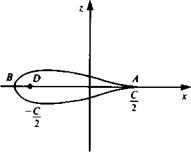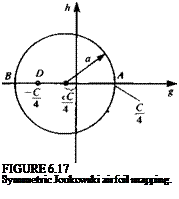Symmetric Joukowski Airfoil
1
Let the center of the circle be taken on the real axis,
(x = – eC/4 €>0 (6.56)
so that from Eq. (6.27)
/3 = 0 a=^(l + e) (6.56a)
The circle is transformed into the airfoil shape shown in Fig. 6.17 (note that e should be small). The surface of the airfoil is given by (Eq. (6.24))
![]() C2
C2
![]() єС C 4 +
єС C 4 +
= — [—e + (1 + e) cos в + i(l + б) sin 0]
 |
 |
Note that Y(-6) = У and therefore the resulting airfoil is symmetric. The chordlength c is given by
с = У(0 = О) + |У(0 = я)|=^{(1 + 2є)[і + ^-^]+2}
-£{3 + 2e + (TT2o) (6’58)
For small e, the chordlength is approximated by
c = j {3 + 2e + 1 – 2e + 4e2 + • • •} = C{ 1 + 4e2 + ■ ■ •} (6.59)
We can therefore take c = C. The velocity at the cusped trailing edge is given by Eq. (6.32) as
and the lift coefficient is (when C is the chord) given by Eq. (6.29a) as
С, = 2я(1 + e) sin a (6.61)
The thickness ratio is approximately equal to 1.299e.











